Human Resource Development Report: Learning, Training, and Development
VerifiedAdded on 2020/01/07
|24
|7421
|90
Report
AI Summary
This report provides a comprehensive analysis of human resource development (HRD) within an organization, using ASDA as a case study. It begins by comparing different learning styles, including the VARK model and Honey and Mumford's learning styles, and explores their implications for training and development. The report then examines the role of the learning curve and its importance in the workplace, as well as the contribution of learning styles and theories in planning and designing effective learning events. Further, it addresses training needs at various staff levels, evaluates different training methods, and outlines a plan for a training event for new employees. The report also details an evaluation plan, reviews the success of the evaluation methods, and discusses the role of government in training and development, including the impact of the competency movement. Finally, it assesses contemporary training initiatives introduced by the UK government.

Human Resource
Development
Development
Paraphrase This Document
Need a fresh take? Get an instant paraphrase of this document with our AI Paraphraser
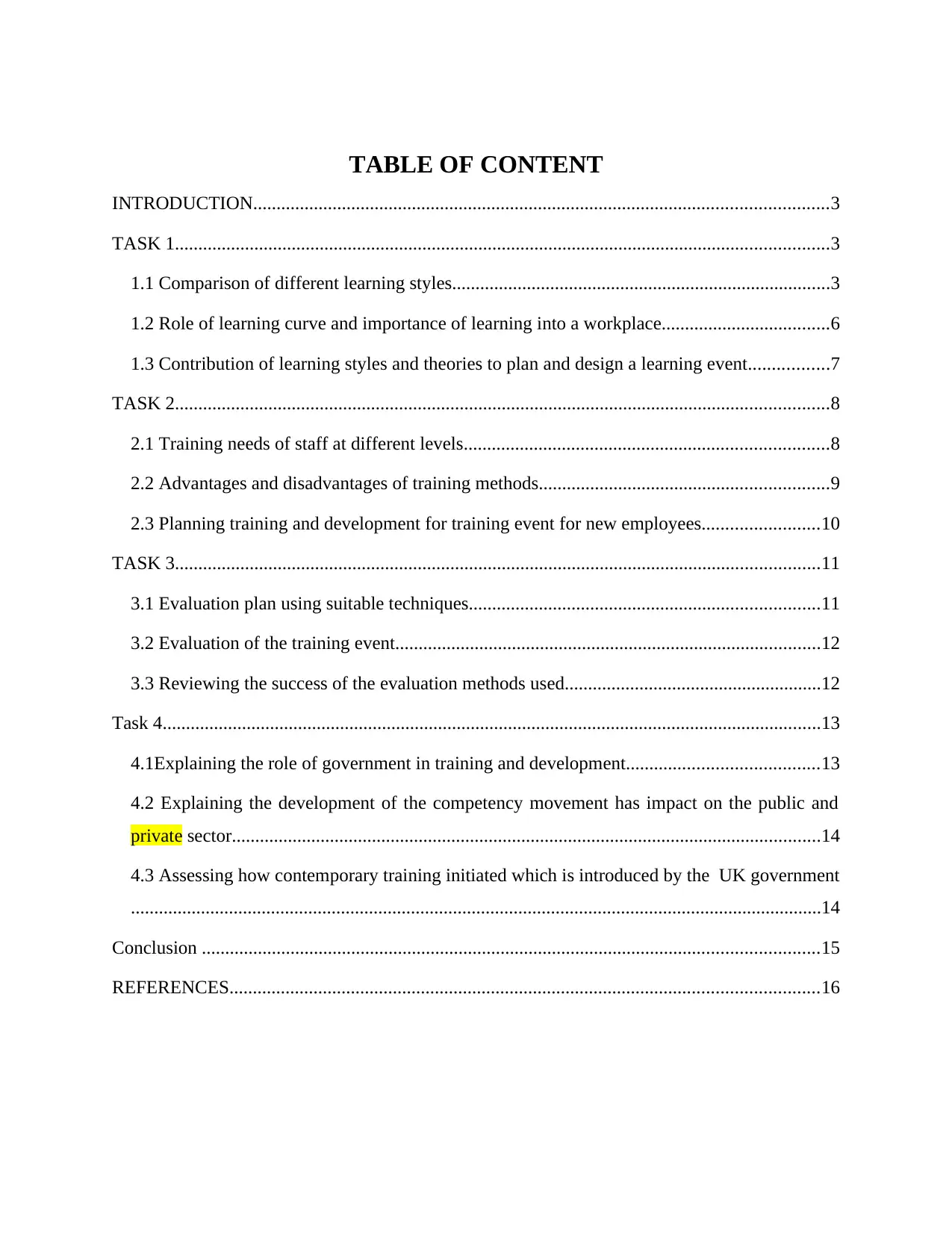
TABLE OF CONTENT
INTRODUCTION...........................................................................................................................3
TASK 1............................................................................................................................................3
1.1 Comparison of different learning styles.................................................................................3
1.2 Role of learning curve and importance of learning into a workplace....................................6
1.3 Contribution of learning styles and theories to plan and design a learning event.................7
TASK 2............................................................................................................................................8
2.1 Training needs of staff at different levels..............................................................................8
2.2 Advantages and disadvantages of training methods..............................................................9
2.3 Planning training and development for training event for new employees.........................10
TASK 3..........................................................................................................................................11
3.1 Evaluation plan using suitable techniques...........................................................................11
3.2 Evaluation of the training event...........................................................................................12
3.3 Reviewing the success of the evaluation methods used.......................................................12
Task 4.............................................................................................................................................13
4.1Explaining the role of government in training and development.........................................13
4.2 Explaining the development of the competency movement has impact on the public and
private sector..............................................................................................................................14
4.3 Assessing how contemporary training initiated which is introduced by the UK government
....................................................................................................................................................14
Conclusion ....................................................................................................................................15
REFERENCES..............................................................................................................................16
INTRODUCTION...........................................................................................................................3
TASK 1............................................................................................................................................3
1.1 Comparison of different learning styles.................................................................................3
1.2 Role of learning curve and importance of learning into a workplace....................................6
1.3 Contribution of learning styles and theories to plan and design a learning event.................7
TASK 2............................................................................................................................................8
2.1 Training needs of staff at different levels..............................................................................8
2.2 Advantages and disadvantages of training methods..............................................................9
2.3 Planning training and development for training event for new employees.........................10
TASK 3..........................................................................................................................................11
3.1 Evaluation plan using suitable techniques...........................................................................11
3.2 Evaluation of the training event...........................................................................................12
3.3 Reviewing the success of the evaluation methods used.......................................................12
Task 4.............................................................................................................................................13
4.1Explaining the role of government in training and development.........................................13
4.2 Explaining the development of the competency movement has impact on the public and
private sector..............................................................................................................................14
4.3 Assessing how contemporary training initiated which is introduced by the UK government
....................................................................................................................................................14
Conclusion ....................................................................................................................................15
REFERENCES..............................................................................................................................16
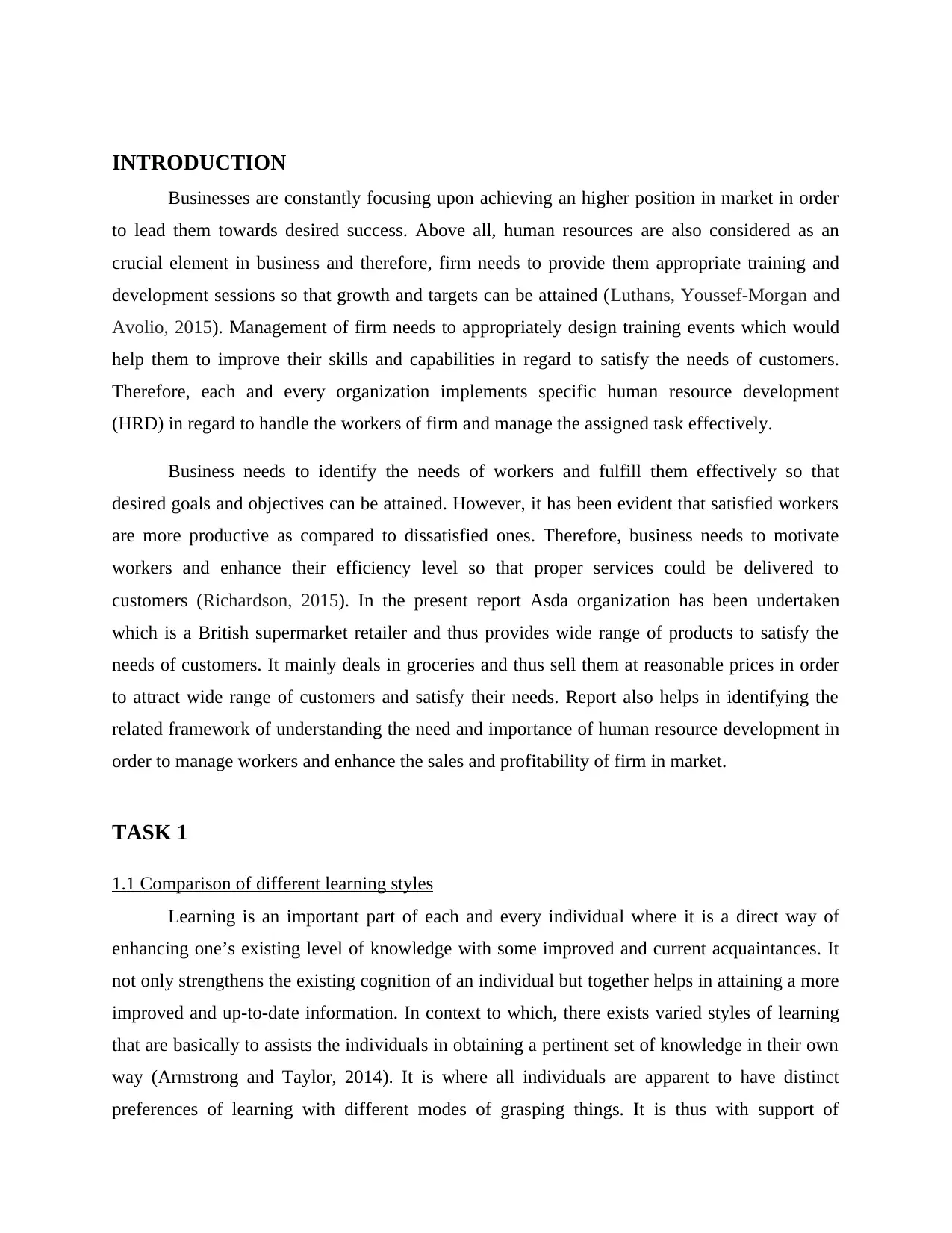
INTRODUCTION
Businesses are constantly focusing upon achieving an higher position in market in order
to lead them towards desired success. Above all, human resources are also considered as an
crucial element in business and therefore, firm needs to provide them appropriate training and
development sessions so that growth and targets can be attained (Luthans, Youssef-Morgan and
Avolio, 2015). Management of firm needs to appropriately design training events which would
help them to improve their skills and capabilities in regard to satisfy the needs of customers.
Therefore, each and every organization implements specific human resource development
(HRD) in regard to handle the workers of firm and manage the assigned task effectively.
Business needs to identify the needs of workers and fulfill them effectively so that
desired goals and objectives can be attained. However, it has been evident that satisfied workers
are more productive as compared to dissatisfied ones. Therefore, business needs to motivate
workers and enhance their efficiency level so that proper services could be delivered to
customers (Richardson, 2015). In the present report Asda organization has been undertaken
which is a British supermarket retailer and thus provides wide range of products to satisfy the
needs of customers. It mainly deals in groceries and thus sell them at reasonable prices in order
to attract wide range of customers and satisfy their needs. Report also helps in identifying the
related framework of understanding the need and importance of human resource development in
order to manage workers and enhance the sales and profitability of firm in market.
TASK 1
1.1 Comparison of different learning styles
Learning is an important part of each and every individual where it is a direct way of
enhancing one’s existing level of knowledge with some improved and current acquaintances. It
not only strengthens the existing cognition of an individual but together helps in attaining a more
improved and up-to-date information. In context to which, there exists varied styles of learning
that are basically to assists the individuals in obtaining a pertinent set of knowledge in their own
way (Armstrong and Taylor, 2014). It is where all individuals are apparent to have distinct
preferences of learning with different modes of grasping things. It is thus with support of
Businesses are constantly focusing upon achieving an higher position in market in order
to lead them towards desired success. Above all, human resources are also considered as an
crucial element in business and therefore, firm needs to provide them appropriate training and
development sessions so that growth and targets can be attained (Luthans, Youssef-Morgan and
Avolio, 2015). Management of firm needs to appropriately design training events which would
help them to improve their skills and capabilities in regard to satisfy the needs of customers.
Therefore, each and every organization implements specific human resource development
(HRD) in regard to handle the workers of firm and manage the assigned task effectively.
Business needs to identify the needs of workers and fulfill them effectively so that
desired goals and objectives can be attained. However, it has been evident that satisfied workers
are more productive as compared to dissatisfied ones. Therefore, business needs to motivate
workers and enhance their efficiency level so that proper services could be delivered to
customers (Richardson, 2015). In the present report Asda organization has been undertaken
which is a British supermarket retailer and thus provides wide range of products to satisfy the
needs of customers. It mainly deals in groceries and thus sell them at reasonable prices in order
to attract wide range of customers and satisfy their needs. Report also helps in identifying the
related framework of understanding the need and importance of human resource development in
order to manage workers and enhance the sales and profitability of firm in market.
TASK 1
1.1 Comparison of different learning styles
Learning is an important part of each and every individual where it is a direct way of
enhancing one’s existing level of knowledge with some improved and current acquaintances. It
not only strengthens the existing cognition of an individual but together helps in attaining a more
improved and up-to-date information. In context to which, there exists varied styles of learning
that are basically to assists the individuals in obtaining a pertinent set of knowledge in their own
way (Armstrong and Taylor, 2014). It is where all individuals are apparent to have distinct
preferences of learning with different modes of grasping things. It is thus with support of
⊘ This is a preview!⊘
Do you want full access?
Subscribe today to unlock all pages.

Trusted by 1+ million students worldwide
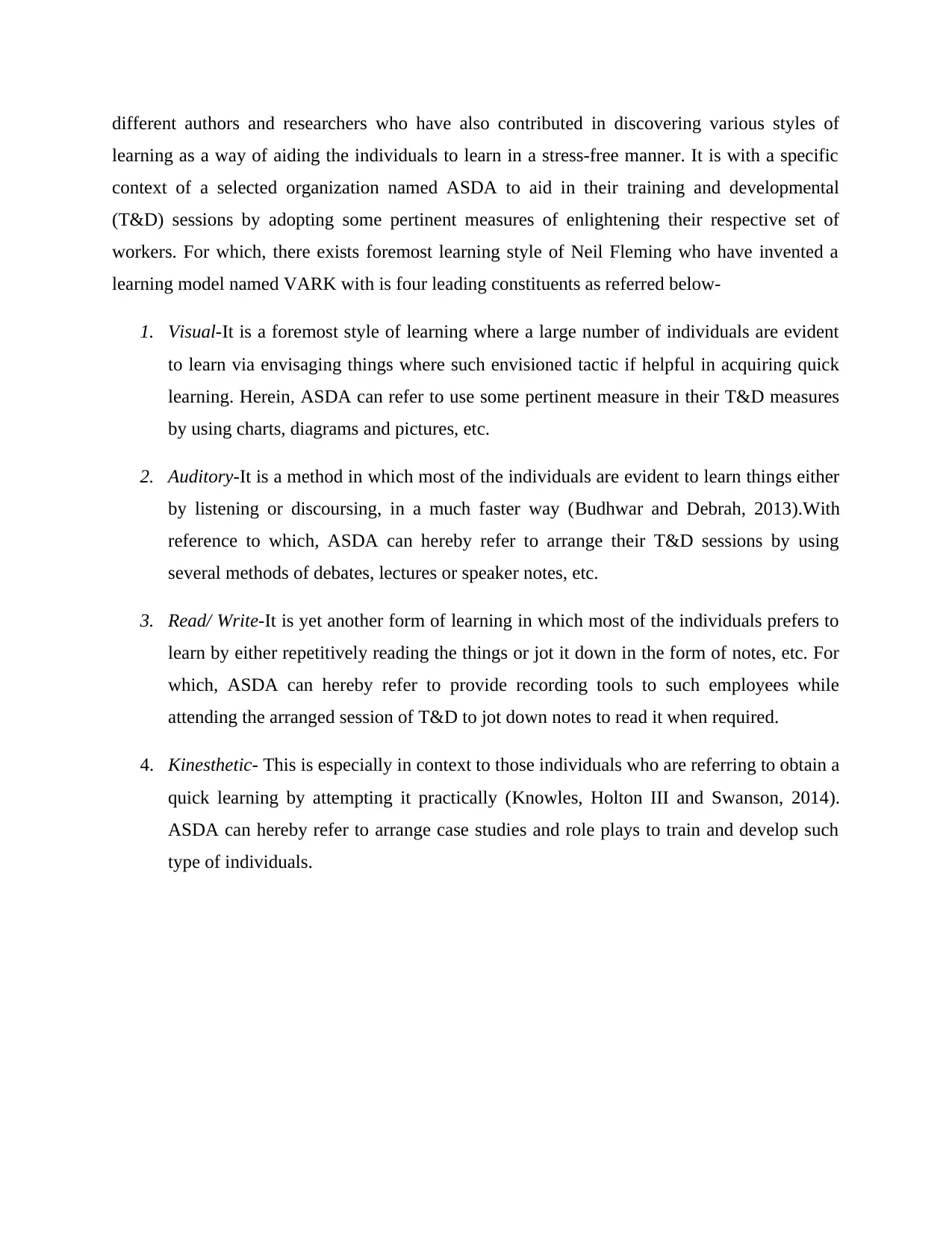
different authors and researchers who have also contributed in discovering various styles of
learning as a way of aiding the individuals to learn in a stress-free manner. It is with a specific
context of a selected organization named ASDA to aid in their training and developmental
(T&D) sessions by adopting some pertinent measures of enlightening their respective set of
workers. For which, there exists foremost learning style of Neil Fleming who have invented a
learning model named VARK with is four leading constituents as referred below-
1. Visual-It is a foremost style of learning where a large number of individuals are evident
to learn via envisaging things where such envisioned tactic if helpful in acquiring quick
learning. Herein, ASDA can refer to use some pertinent measure in their T&D measures
by using charts, diagrams and pictures, etc.
2. Auditory-It is a method in which most of the individuals are evident to learn things either
by listening or discoursing, in a much faster way (Budhwar and Debrah, 2013).With
reference to which, ASDA can hereby refer to arrange their T&D sessions by using
several methods of debates, lectures or speaker notes, etc.
3. Read/ Write-It is yet another form of learning in which most of the individuals prefers to
learn by either repetitively reading the things or jot it down in the form of notes, etc. For
which, ASDA can hereby refer to provide recording tools to such employees while
attending the arranged session of T&D to jot down notes to read it when required.
4. Kinesthetic- This is especially in context to those individuals who are referring to obtain a
quick learning by attempting it practically (Knowles, Holton III and Swanson, 2014).
ASDA can hereby refer to arrange case studies and role plays to train and develop such
type of individuals.
learning as a way of aiding the individuals to learn in a stress-free manner. It is with a specific
context of a selected organization named ASDA to aid in their training and developmental
(T&D) sessions by adopting some pertinent measures of enlightening their respective set of
workers. For which, there exists foremost learning style of Neil Fleming who have invented a
learning model named VARK with is four leading constituents as referred below-
1. Visual-It is a foremost style of learning where a large number of individuals are evident
to learn via envisaging things where such envisioned tactic if helpful in acquiring quick
learning. Herein, ASDA can refer to use some pertinent measure in their T&D measures
by using charts, diagrams and pictures, etc.
2. Auditory-It is a method in which most of the individuals are evident to learn things either
by listening or discoursing, in a much faster way (Budhwar and Debrah, 2013).With
reference to which, ASDA can hereby refer to arrange their T&D sessions by using
several methods of debates, lectures or speaker notes, etc.
3. Read/ Write-It is yet another form of learning in which most of the individuals prefers to
learn by either repetitively reading the things or jot it down in the form of notes, etc. For
which, ASDA can hereby refer to provide recording tools to such employees while
attending the arranged session of T&D to jot down notes to read it when required.
4. Kinesthetic- This is especially in context to those individuals who are referring to obtain a
quick learning by attempting it practically (Knowles, Holton III and Swanson, 2014).
ASDA can hereby refer to arrange case studies and role plays to train and develop such
type of individuals.
Paraphrase This Document
Need a fresh take? Get an instant paraphrase of this document with our AI Paraphraser
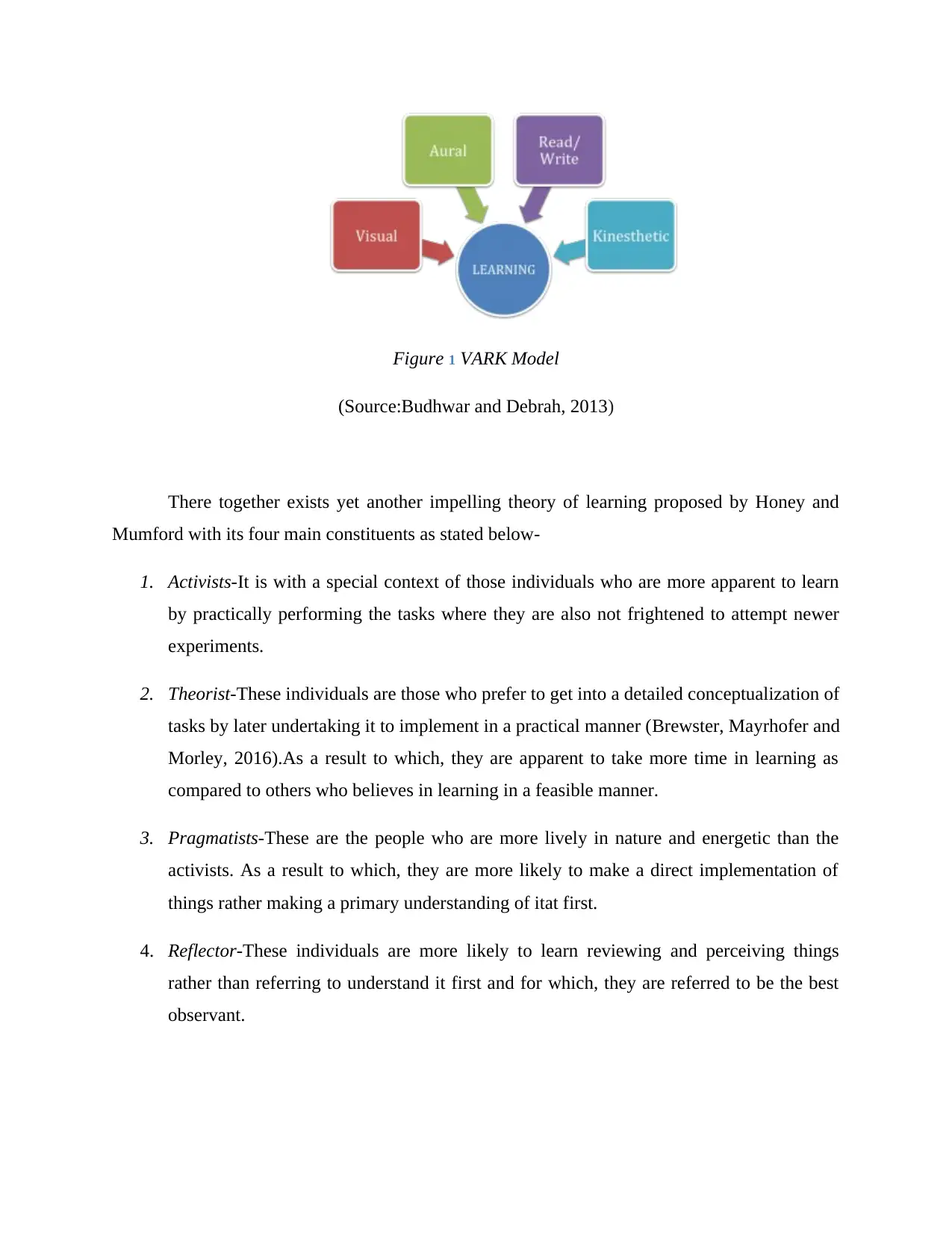
Figure 1 VARK Model
(Source:Budhwar and Debrah, 2013)
There together exists yet another impelling theory of learning proposed by Honey and
Mumford with its four main constituents as stated below-
1. Activists-It is with a special context of those individuals who are more apparent to learn
by practically performing the tasks where they are also not frightened to attempt newer
experiments.
2. Theorist-These individuals are those who prefer to get into a detailed conceptualization of
tasks by later undertaking it to implement in a practical manner (Brewster, Mayrhofer and
Morley, 2016).As a result to which, they are apparent to take more time in learning as
compared to others who believes in learning in a feasible manner.
3. Pragmatists-These are the people who are more lively in nature and energetic than the
activists. As a result to which, they are more likely to make a direct implementation of
things rather making a primary understanding of itat first.
4. Reflector-These individuals are more likely to learn reviewing and perceiving things
rather than referring to understand it first and for which, they are referred to be the best
observant.
(Source:Budhwar and Debrah, 2013)
There together exists yet another impelling theory of learning proposed by Honey and
Mumford with its four main constituents as stated below-
1. Activists-It is with a special context of those individuals who are more apparent to learn
by practically performing the tasks where they are also not frightened to attempt newer
experiments.
2. Theorist-These individuals are those who prefer to get into a detailed conceptualization of
tasks by later undertaking it to implement in a practical manner (Brewster, Mayrhofer and
Morley, 2016).As a result to which, they are apparent to take more time in learning as
compared to others who believes in learning in a feasible manner.
3. Pragmatists-These are the people who are more lively in nature and energetic than the
activists. As a result to which, they are more likely to make a direct implementation of
things rather making a primary understanding of itat first.
4. Reflector-These individuals are more likely to learn reviewing and perceiving things
rather than referring to understand it first and for which, they are referred to be the best
observant.
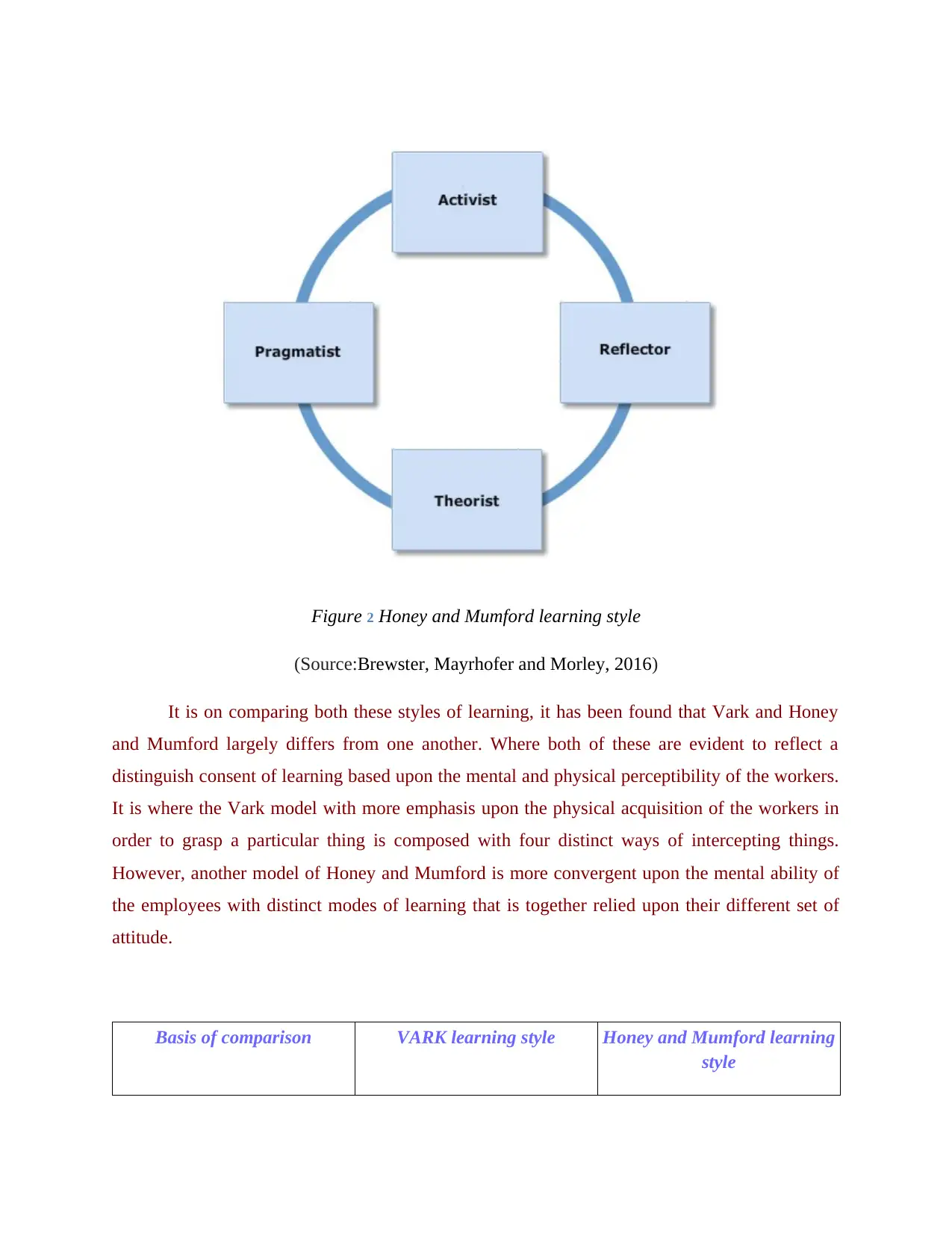
Figure 2 Honey and Mumford learning style
(Source:Brewster, Mayrhofer and Morley, 2016)
It is on comparing both these styles of learning, it has been found that Vark and Honey
and Mumford largely differs from one another. Where both of these are evident to reflect a
distinguish consent of learning based upon the mental and physical perceptibility of the workers.
It is where the Vark model with more emphasis upon the physical acquisition of the workers in
order to grasp a particular thing is composed with four distinct ways of intercepting things.
However, another model of Honey and Mumford is more convergent upon the mental ability of
the employees with distinct modes of learning that is together relied upon their different set of
attitude.
Basis of comparison VARK learning style Honey and Mumford learning
style
(Source:Brewster, Mayrhofer and Morley, 2016)
It is on comparing both these styles of learning, it has been found that Vark and Honey
and Mumford largely differs from one another. Where both of these are evident to reflect a
distinguish consent of learning based upon the mental and physical perceptibility of the workers.
It is where the Vark model with more emphasis upon the physical acquisition of the workers in
order to grasp a particular thing is composed with four distinct ways of intercepting things.
However, another model of Honey and Mumford is more convergent upon the mental ability of
the employees with distinct modes of learning that is together relied upon their different set of
attitude.
Basis of comparison VARK learning style Honey and Mumford learning
style
⊘ This is a preview!⊘
Do you want full access?
Subscribe today to unlock all pages.

Trusted by 1+ million students worldwide
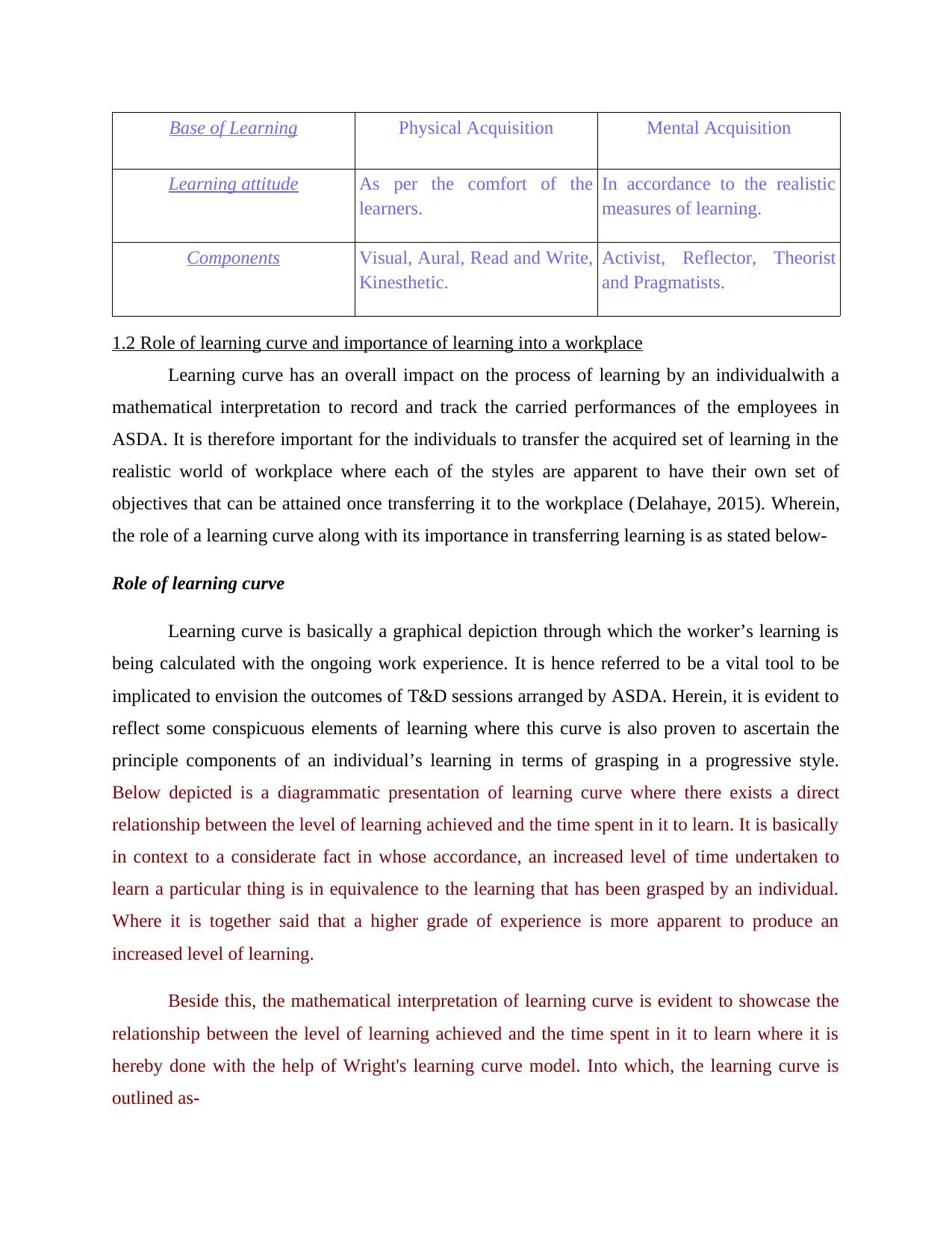
Base of Learning Physical Acquisition Mental Acquisition
Learning attitude As per the comfort of the
learners.
In accordance to the realistic
measures of learning.
Components Visual, Aural, Read and Write,
Kinesthetic.
Activist, Reflector, Theorist
and Pragmatists.
1.2 Role of learning curve and importance of learning into a workplace
Learning curve has an overall impact on the process of learning by an individualwith a
mathematical interpretation to record and track the carried performances of the employees in
ASDA. It is therefore important for the individuals to transfer the acquired set of learning in the
realistic world of workplace where each of the styles are apparent to have their own set of
objectives that can be attained once transferring it to the workplace (Delahaye, 2015). Wherein,
the role of a learning curve along with its importance in transferring learning is as stated below-
Role of learning curve
Learning curve is basically a graphical depiction through which the worker’s learning is
being calculated with the ongoing work experience. It is hence referred to be a vital tool to be
implicated to envision the outcomes of T&D sessions arranged by ASDA. Herein, it is evident to
reflect some conspicuous elements of learning where this curve is also proven to ascertain the
principle components of an individual’s learning in terms of grasping in a progressive style.
Below depicted is a diagrammatic presentation of learning curve where there exists a direct
relationship between the level of learning achieved and the time spent in it to learn. It is basically
in context to a considerate fact in whose accordance, an increased level of time undertaken to
learn a particular thing is in equivalence to the learning that has been grasped by an individual.
Where it is together said that a higher grade of experience is more apparent to produce an
increased level of learning.
Beside this, the mathematical interpretation of learning curve is evident to showcase the
relationship between the level of learning achieved and the time spent in it to learn where it is
hereby done with the help of Wright's learning curve model. Into which, the learning curve is
outlined as-
Learning attitude As per the comfort of the
learners.
In accordance to the realistic
measures of learning.
Components Visual, Aural, Read and Write,
Kinesthetic.
Activist, Reflector, Theorist
and Pragmatists.
1.2 Role of learning curve and importance of learning into a workplace
Learning curve has an overall impact on the process of learning by an individualwith a
mathematical interpretation to record and track the carried performances of the employees in
ASDA. It is therefore important for the individuals to transfer the acquired set of learning in the
realistic world of workplace where each of the styles are apparent to have their own set of
objectives that can be attained once transferring it to the workplace (Delahaye, 2015). Wherein,
the role of a learning curve along with its importance in transferring learning is as stated below-
Role of learning curve
Learning curve is basically a graphical depiction through which the worker’s learning is
being calculated with the ongoing work experience. It is hence referred to be a vital tool to be
implicated to envision the outcomes of T&D sessions arranged by ASDA. Herein, it is evident to
reflect some conspicuous elements of learning where this curve is also proven to ascertain the
principle components of an individual’s learning in terms of grasping in a progressive style.
Below depicted is a diagrammatic presentation of learning curve where there exists a direct
relationship between the level of learning achieved and the time spent in it to learn. It is basically
in context to a considerate fact in whose accordance, an increased level of time undertaken to
learn a particular thing is in equivalence to the learning that has been grasped by an individual.
Where it is together said that a higher grade of experience is more apparent to produce an
increased level of learning.
Beside this, the mathematical interpretation of learning curve is evident to showcase the
relationship between the level of learning achieved and the time spent in it to learn where it is
hereby done with the help of Wright's learning curve model. Into which, the learning curve is
outlined as-
Paraphrase This Document
Need a fresh take? Get an instant paraphrase of this document with our AI Paraphraser
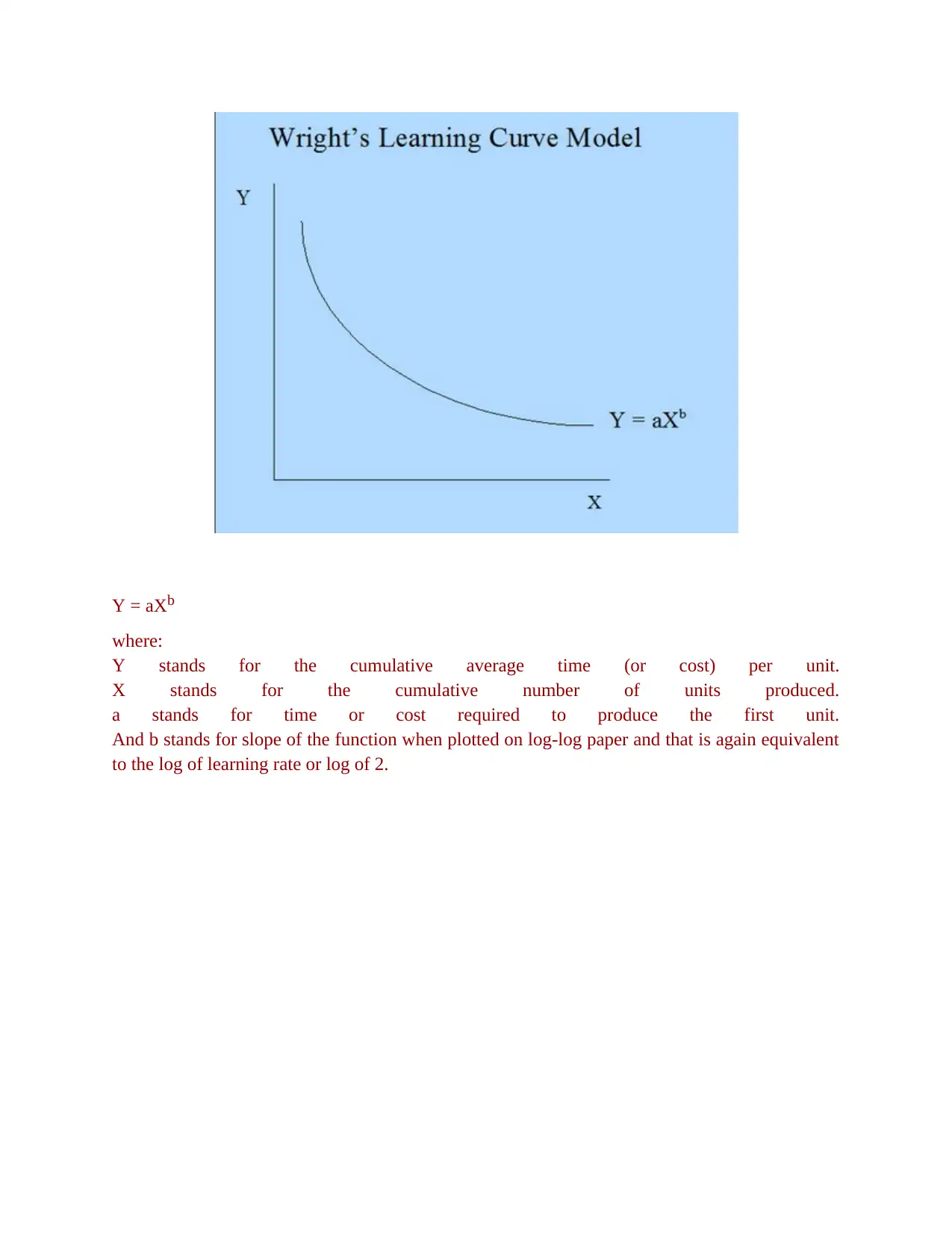
Y = aXb
where:
Y stands for the cumulative average time (or cost) per unit.
X stands for the cumulative number of units produced.
a stands for time or cost required to produce the first unit.
And b stands for slope of the function when plotted on log-log paper and that is again equivalent
to the log of learning rate or log of 2.
where:
Y stands for the cumulative average time (or cost) per unit.
X stands for the cumulative number of units produced.
a stands for time or cost required to produce the first unit.
And b stands for slope of the function when plotted on log-log paper and that is again equivalent
to the log of learning rate or log of 2.
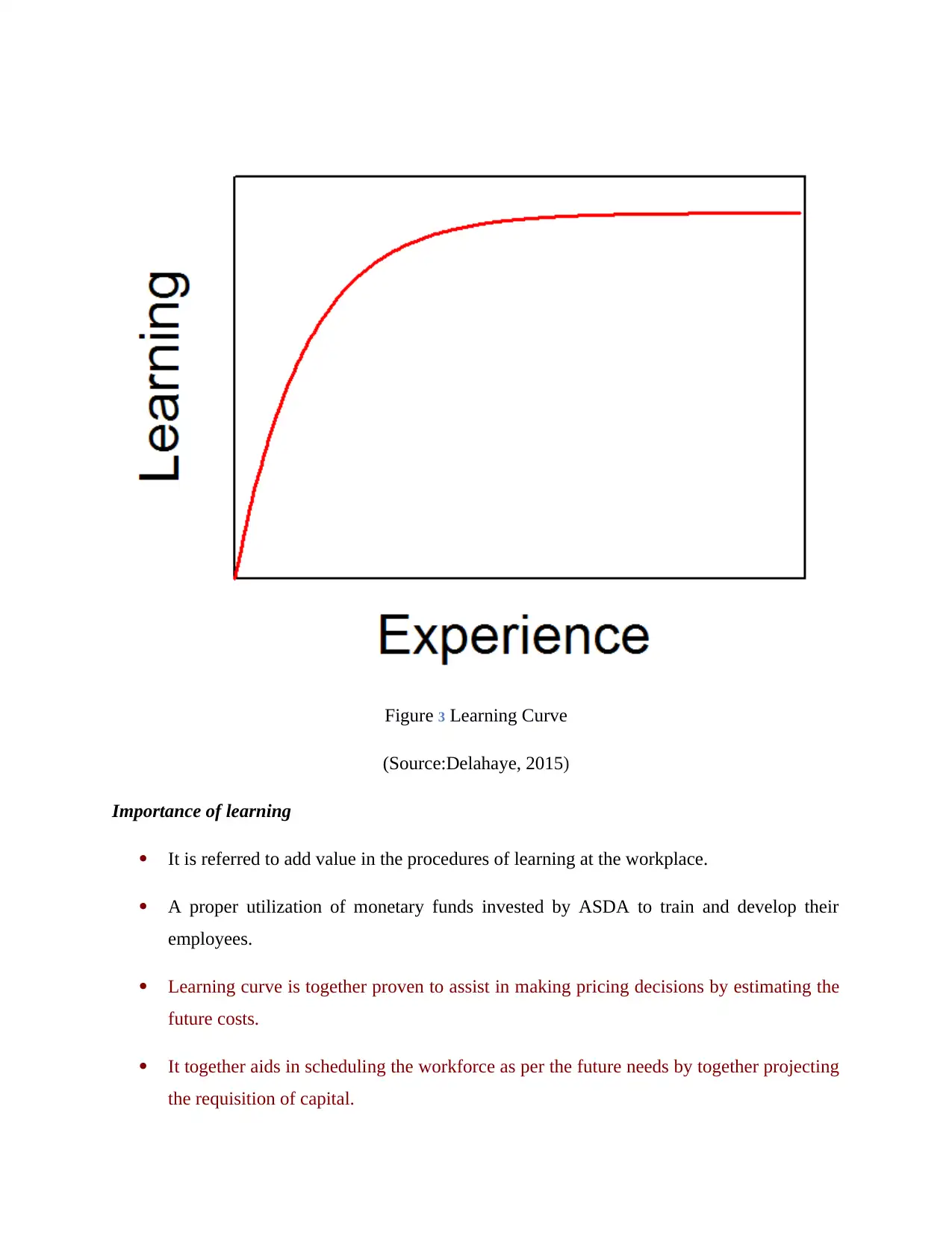
Figure 3 Learning Curve
(Source:Delahaye, 2015)
Importance of learning
It is referred to add value in the procedures of learning at the workplace.
A proper utilization of monetary funds invested by ASDA to train and develop their
employees.
Learning curve is together proven to assist in making pricing decisions by estimating the
future costs.
It together aids in scheduling the workforce as per the future needs by together projecting
the requisition of capital.
(Source:Delahaye, 2015)
Importance of learning
It is referred to add value in the procedures of learning at the workplace.
A proper utilization of monetary funds invested by ASDA to train and develop their
employees.
Learning curve is together proven to assist in making pricing decisions by estimating the
future costs.
It together aids in scheduling the workforce as per the future needs by together projecting
the requisition of capital.
⊘ This is a preview!⊘
Do you want full access?
Subscribe today to unlock all pages.

Trusted by 1+ million students worldwide
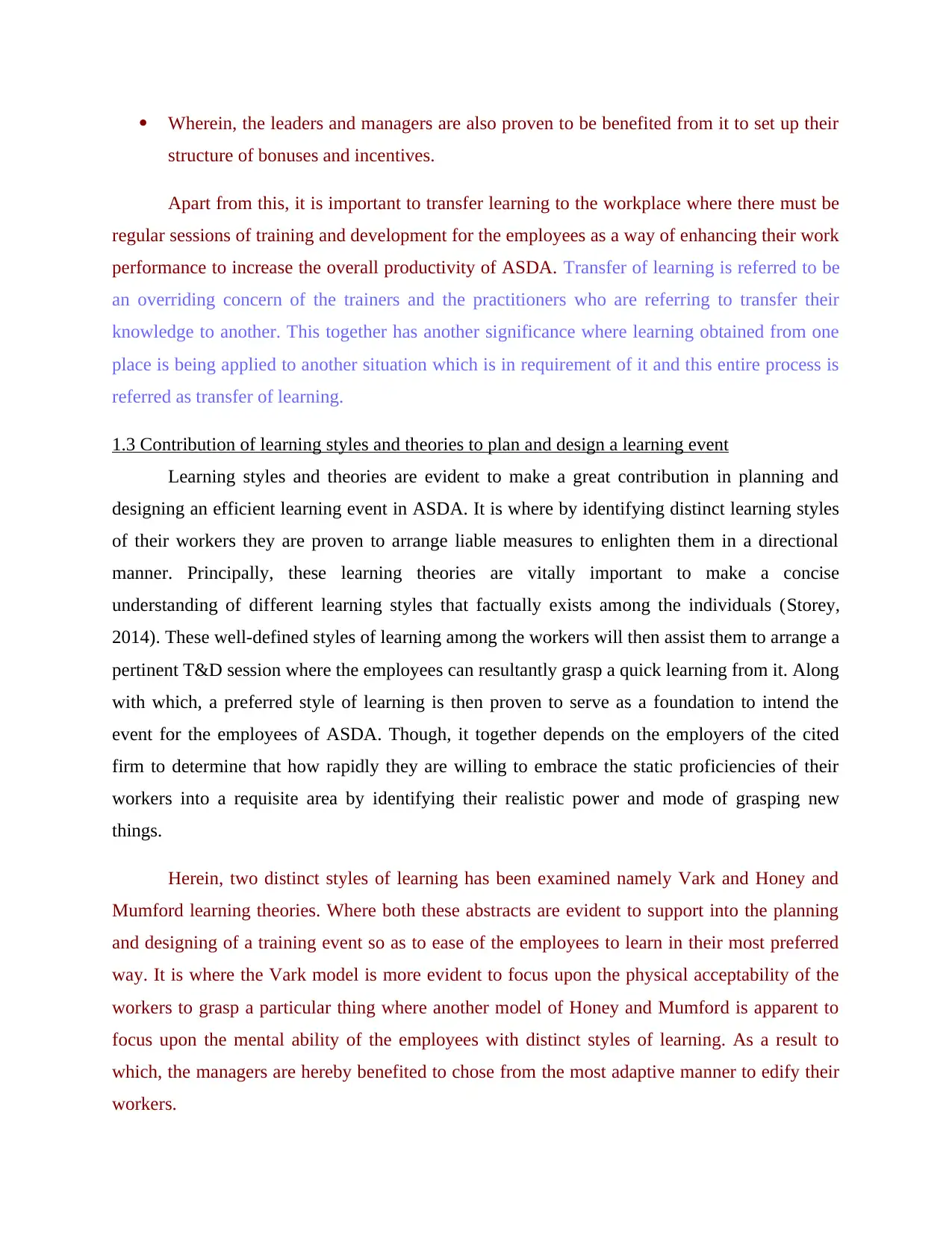
Wherein, the leaders and managers are also proven to be benefited from it to set up their
structure of bonuses and incentives.
Apart from this, it is important to transfer learning to the workplace where there must be
regular sessions of training and development for the employees as a way of enhancing their work
performance to increase the overall productivity of ASDA. Transfer of learning is referred to be
an overriding concern of the trainers and the practitioners who are referring to transfer their
knowledge to another. This together has another significance where learning obtained from one
place is being applied to another situation which is in requirement of it and this entire process is
referred as transfer of learning.
1.3 Contribution of learning styles and theories to plan and design a learning event
Learning styles and theories are evident to make a great contribution in planning and
designing an efficient learning event in ASDA. It is where by identifying distinct learning styles
of their workers they are proven to arrange liable measures to enlighten them in a directional
manner. Principally, these learning theories are vitally important to make a concise
understanding of different learning styles that factually exists among the individuals (Storey,
2014). These well-defined styles of learning among the workers will then assist them to arrange a
pertinent T&D session where the employees can resultantly grasp a quick learning from it. Along
with which, a preferred style of learning is then proven to serve as a foundation to intend the
event for the employees of ASDA. Though, it together depends on the employers of the cited
firm to determine that how rapidly they are willing to embrace the static proficiencies of their
workers into a requisite area by identifying their realistic power and mode of grasping new
things.
Herein, two distinct styles of learning has been examined namely Vark and Honey and
Mumford learning theories. Where both these abstracts are evident to support into the planning
and designing of a training event so as to ease of the employees to learn in their most preferred
way. It is where the Vark model is more evident to focus upon the physical acceptability of the
workers to grasp a particular thing where another model of Honey and Mumford is apparent to
focus upon the mental ability of the employees with distinct styles of learning. As a result to
which, the managers are hereby benefited to chose from the most adaptive manner to edify their
workers.
structure of bonuses and incentives.
Apart from this, it is important to transfer learning to the workplace where there must be
regular sessions of training and development for the employees as a way of enhancing their work
performance to increase the overall productivity of ASDA. Transfer of learning is referred to be
an overriding concern of the trainers and the practitioners who are referring to transfer their
knowledge to another. This together has another significance where learning obtained from one
place is being applied to another situation which is in requirement of it and this entire process is
referred as transfer of learning.
1.3 Contribution of learning styles and theories to plan and design a learning event
Learning styles and theories are evident to make a great contribution in planning and
designing an efficient learning event in ASDA. It is where by identifying distinct learning styles
of their workers they are proven to arrange liable measures to enlighten them in a directional
manner. Principally, these learning theories are vitally important to make a concise
understanding of different learning styles that factually exists among the individuals (Storey,
2014). These well-defined styles of learning among the workers will then assist them to arrange a
pertinent T&D session where the employees can resultantly grasp a quick learning from it. Along
with which, a preferred style of learning is then proven to serve as a foundation to intend the
event for the employees of ASDA. Though, it together depends on the employers of the cited
firm to determine that how rapidly they are willing to embrace the static proficiencies of their
workers into a requisite area by identifying their realistic power and mode of grasping new
things.
Herein, two distinct styles of learning has been examined namely Vark and Honey and
Mumford learning theories. Where both these abstracts are evident to support into the planning
and designing of a training event so as to ease of the employees to learn in their most preferred
way. It is where the Vark model is more evident to focus upon the physical acceptability of the
workers to grasp a particular thing where another model of Honey and Mumford is apparent to
focus upon the mental ability of the employees with distinct styles of learning. As a result to
which, the managers are hereby benefited to chose from the most adaptive manner to edify their
workers.
Paraphrase This Document
Need a fresh take? Get an instant paraphrase of this document with our AI Paraphraser
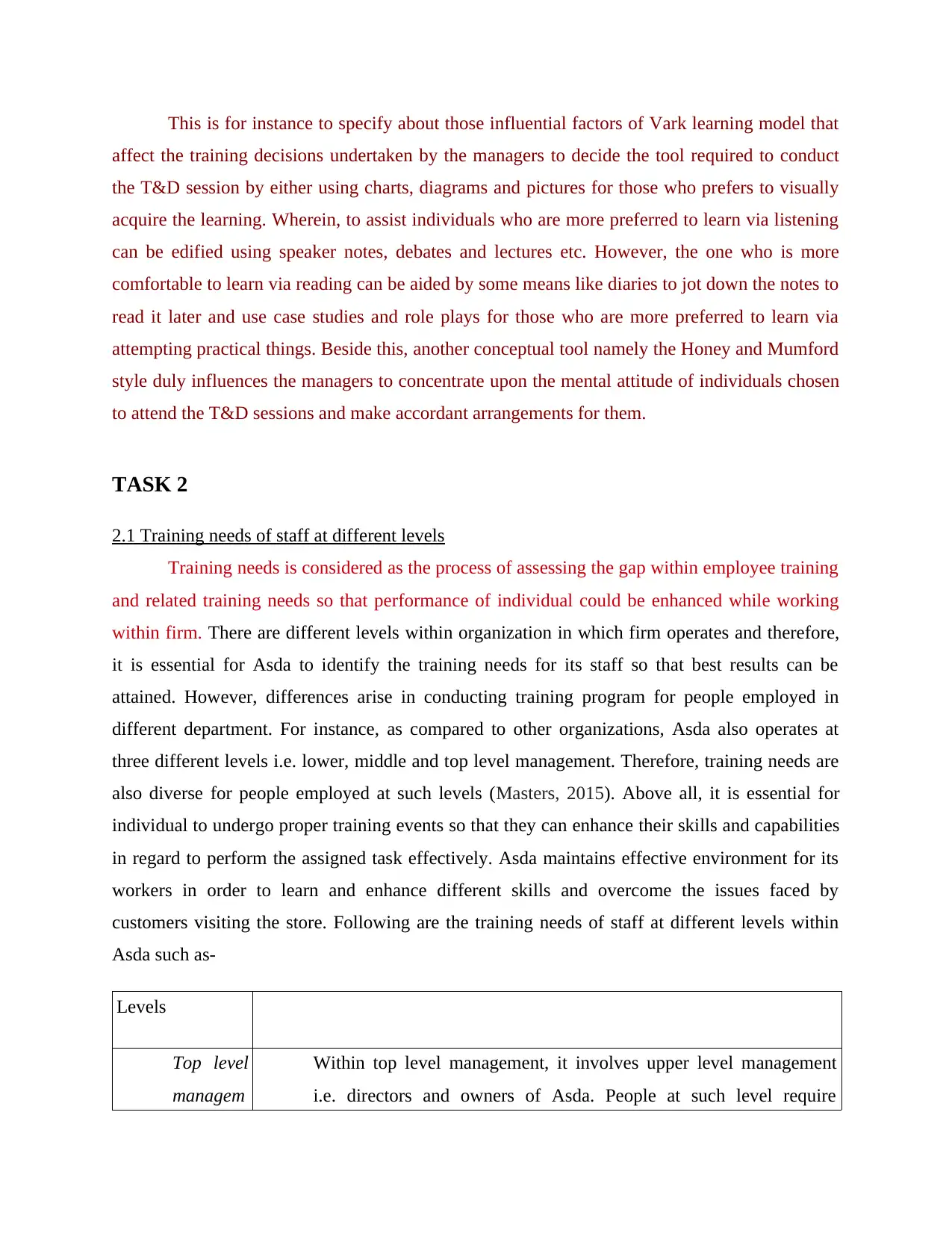
This is for instance to specify about those influential factors of Vark learning model that
affect the training decisions undertaken by the managers to decide the tool required to conduct
the T&D session by either using charts, diagrams and pictures for those who prefers to visually
acquire the learning. Wherein, to assist individuals who are more preferred to learn via listening
can be edified using speaker notes, debates and lectures etc. However, the one who is more
comfortable to learn via reading can be aided by some means like diaries to jot down the notes to
read it later and use case studies and role plays for those who are more preferred to learn via
attempting practical things. Beside this, another conceptual tool namely the Honey and Mumford
style duly influences the managers to concentrate upon the mental attitude of individuals chosen
to attend the T&D sessions and make accordant arrangements for them.
TASK 2
2.1 Training needs of staff at different levels
Training needs is considered as the process of assessing the gap within employee training
and related training needs so that performance of individual could be enhanced while working
within firm. There are different levels within organization in which firm operates and therefore,
it is essential for Asda to identify the training needs for its staff so that best results can be
attained. However, differences arise in conducting training program for people employed in
different department. For instance, as compared to other organizations, Asda also operates at
three different levels i.e. lower, middle and top level management. Therefore, training needs are
also diverse for people employed at such levels (Masters, 2015). Above all, it is essential for
individual to undergo proper training events so that they can enhance their skills and capabilities
in regard to perform the assigned task effectively. Asda maintains effective environment for its
workers in order to learn and enhance different skills and overcome the issues faced by
customers visiting the store. Following are the training needs of staff at different levels within
Asda such as-
Levels
Top level
managem
Within top level management, it involves upper level management
i.e. directors and owners of Asda. People at such level require
affect the training decisions undertaken by the managers to decide the tool required to conduct
the T&D session by either using charts, diagrams and pictures for those who prefers to visually
acquire the learning. Wherein, to assist individuals who are more preferred to learn via listening
can be edified using speaker notes, debates and lectures etc. However, the one who is more
comfortable to learn via reading can be aided by some means like diaries to jot down the notes to
read it later and use case studies and role plays for those who are more preferred to learn via
attempting practical things. Beside this, another conceptual tool namely the Honey and Mumford
style duly influences the managers to concentrate upon the mental attitude of individuals chosen
to attend the T&D sessions and make accordant arrangements for them.
TASK 2
2.1 Training needs of staff at different levels
Training needs is considered as the process of assessing the gap within employee training
and related training needs so that performance of individual could be enhanced while working
within firm. There are different levels within organization in which firm operates and therefore,
it is essential for Asda to identify the training needs for its staff so that best results can be
attained. However, differences arise in conducting training program for people employed in
different department. For instance, as compared to other organizations, Asda also operates at
three different levels i.e. lower, middle and top level management. Therefore, training needs are
also diverse for people employed at such levels (Masters, 2015). Above all, it is essential for
individual to undergo proper training events so that they can enhance their skills and capabilities
in regard to perform the assigned task effectively. Asda maintains effective environment for its
workers in order to learn and enhance different skills and overcome the issues faced by
customers visiting the store. Following are the training needs of staff at different levels within
Asda such as-
Levels
Top level
managem
Within top level management, it involves upper level management
i.e. directors and owners of Asda. People at such level require
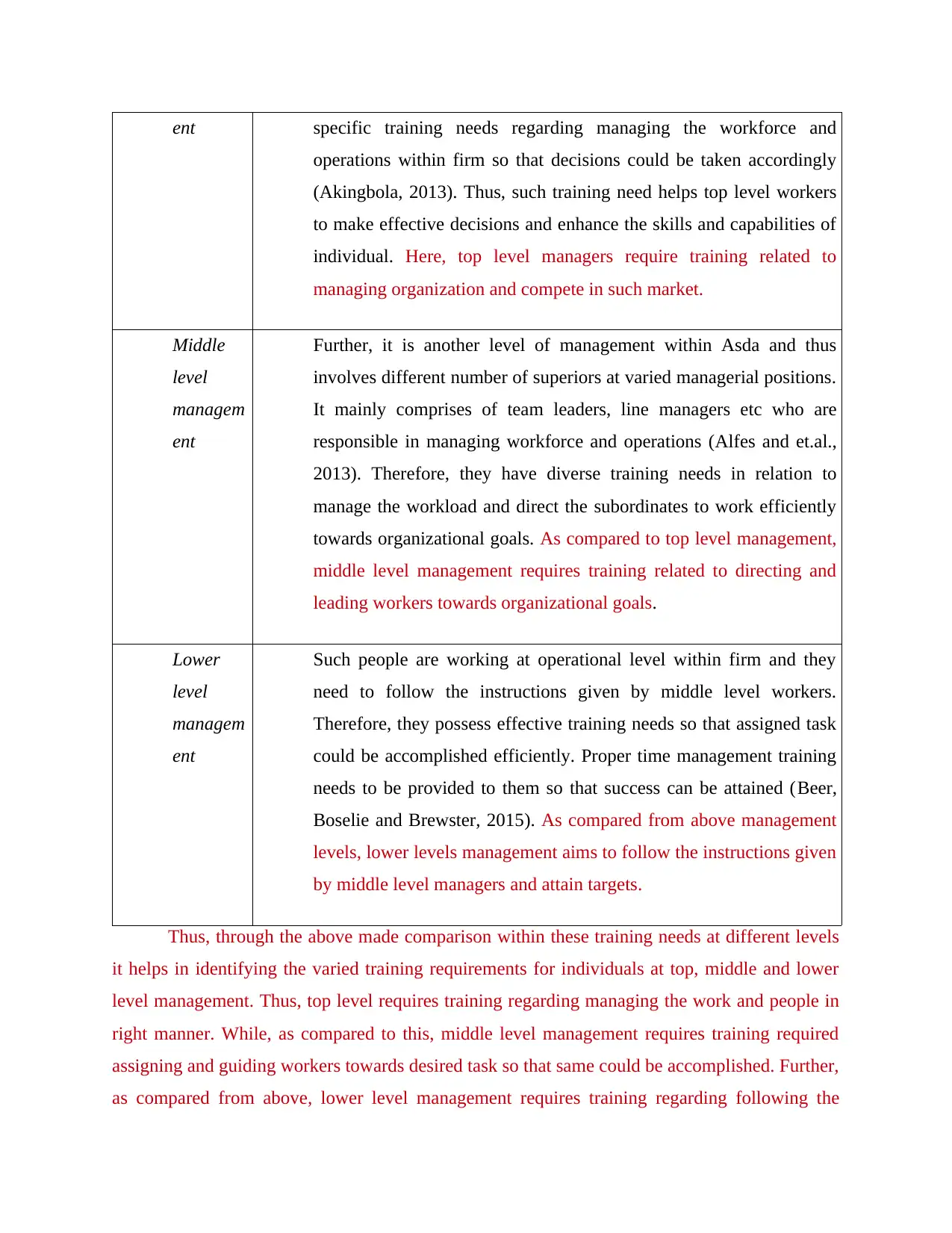
ent specific training needs regarding managing the workforce and
operations within firm so that decisions could be taken accordingly
(Akingbola, 2013). Thus, such training need helps top level workers
to make effective decisions and enhance the skills and capabilities of
individual. Here, top level managers require training related to
managing organization and compete in such market.
Middle
level
managem
ent
Further, it is another level of management within Asda and thus
involves different number of superiors at varied managerial positions.
It mainly comprises of team leaders, line managers etc who are
responsible in managing workforce and operations (Alfes and et.al.,
2013). Therefore, they have diverse training needs in relation to
manage the workload and direct the subordinates to work efficiently
towards organizational goals. As compared to top level management,
middle level management requires training related to directing and
leading workers towards organizational goals.
Lower
level
managem
ent
Such people are working at operational level within firm and they
need to follow the instructions given by middle level workers.
Therefore, they possess effective training needs so that assigned task
could be accomplished efficiently. Proper time management training
needs to be provided to them so that success can be attained (Beer,
Boselie and Brewster, 2015). As compared from above management
levels, lower levels management aims to follow the instructions given
by middle level managers and attain targets.
Thus, through the above made comparison within these training needs at different levels
it helps in identifying the varied training requirements for individuals at top, middle and lower
level management. Thus, top level requires training regarding managing the work and people in
right manner. While, as compared to this, middle level management requires training required
assigning and guiding workers towards desired task so that same could be accomplished. Further,
as compared from above, lower level management requires training regarding following the
operations within firm so that decisions could be taken accordingly
(Akingbola, 2013). Thus, such training need helps top level workers
to make effective decisions and enhance the skills and capabilities of
individual. Here, top level managers require training related to
managing organization and compete in such market.
Middle
level
managem
ent
Further, it is another level of management within Asda and thus
involves different number of superiors at varied managerial positions.
It mainly comprises of team leaders, line managers etc who are
responsible in managing workforce and operations (Alfes and et.al.,
2013). Therefore, they have diverse training needs in relation to
manage the workload and direct the subordinates to work efficiently
towards organizational goals. As compared to top level management,
middle level management requires training related to directing and
leading workers towards organizational goals.
Lower
level
managem
ent
Such people are working at operational level within firm and they
need to follow the instructions given by middle level workers.
Therefore, they possess effective training needs so that assigned task
could be accomplished efficiently. Proper time management training
needs to be provided to them so that success can be attained (Beer,
Boselie and Brewster, 2015). As compared from above management
levels, lower levels management aims to follow the instructions given
by middle level managers and attain targets.
Thus, through the above made comparison within these training needs at different levels
it helps in identifying the varied training requirements for individuals at top, middle and lower
level management. Thus, top level requires training regarding managing the work and people in
right manner. While, as compared to this, middle level management requires training required
assigning and guiding workers towards desired task so that same could be accomplished. Further,
as compared from above, lower level management requires training regarding following the
⊘ This is a preview!⊘
Do you want full access?
Subscribe today to unlock all pages.

Trusted by 1+ million students worldwide
1 out of 24
Related Documents
Your All-in-One AI-Powered Toolkit for Academic Success.
+13062052269
info@desklib.com
Available 24*7 on WhatsApp / Email
![[object Object]](/_next/static/media/star-bottom.7253800d.svg)
Unlock your academic potential
Copyright © 2020–2025 A2Z Services. All Rights Reserved. Developed and managed by ZUCOL.





